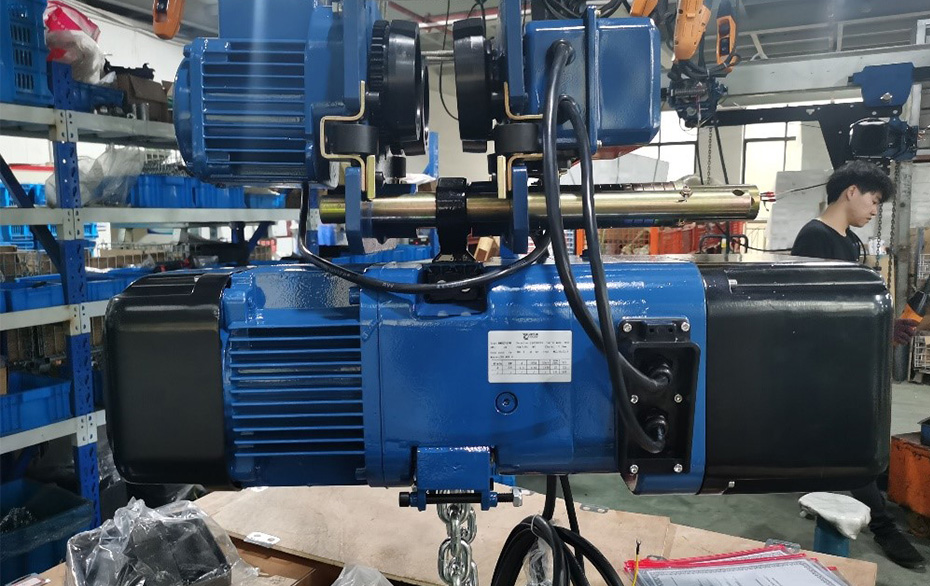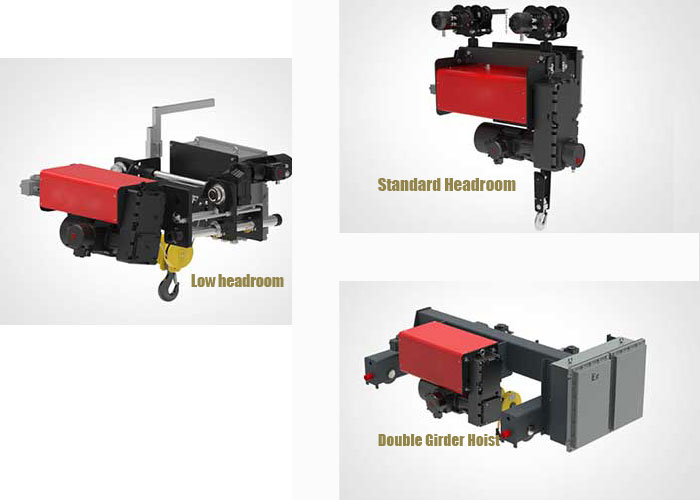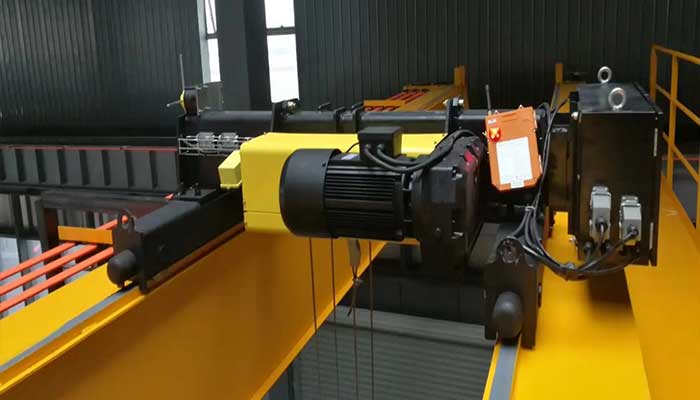Cheap Electric Chain Hoist vs. Rope Hoist, Hot Sale 3 T, 5 T, 10 T
Cheap Electric Chain Hoist vs. Wire Rope Hoist Comparison Guide. Check differences in functions, uses & benefits while considering their cost-effectiveness.
Comparison Guide: Cheap Electric Chain Hoist vs. Wire Rope Hoist
Selecting the appropriate hoist for lifting heavy loads is a critical decision across industries. The efficiency, safety, and successful completion of tasks heavily rely on this choice. Different hoists cater to specific requirements, making it essential to understand their functionalities and applications thoroughly.
Among the array of hoists available, two popular choices stand out: the electric chain hoist and the wire rope hoist. Both offer distinct features and advantages tailored to varying lifting needs. By examining their differences in functionality, applications, benefits, and cost-effectiveness, a clearer understanding emerges, aiding in informed decision-making.
Electric Chain Hoist Overview
Electric chain hoists are robust and versatile lifting devices widely used in various industries for lifting heavy loads with precision and efficiency. They operate using a chain mechanism powered by an electric motor, offering controlled lifting and lowering of objects. These hoists come in different types, each tailored to specific lifting needs and space constraints:
Standard Headroom Electric Chain Hoist
This type of electric chain hoist features a standard headroom design, allowing adequate vertical space between the hoist and the load. It's suitable for lifting applications where there's enough headroom clearance. These hoists are versatile and commonly used in industries such as manufacturing, construction, and warehouses for lifting moderate to heavy loads.
Low Headroom Electric Chain Hoist
The low headroom electric chain hoist is designed for operations where vertical space is limited. Its compact design minimizes the required headroom, making it suitable for lifting in areas with restricted space. These hoists offer efficient lifting solutions while operating in confined spaces, often seen in workshops, assembly lines, and areas with low ceilings.
Double Hook Electric Chain Hoist
Double hook electric chain hoists feature two load hooks operating independently on a single hoist unit. These hoists are beneficial for tasks that require lifting multiple loads or spreading the load weight between two hooks for better balance and control. They are utilized in applications where lifting points are spaced apart or where handling several loads simultaneously is necessary.
Each type of electric chain hoist is designed to meet specific lifting requirements and spatial limitations. The selection of the appropriate hoist type involves considering factors such as lifting capacity, available headroom, load configuration, and the operational environment. By choosing the right electric chain hoist variant, industries can ensure safe, efficient, and precise lifting operations in diverse work settings.
A. Description and Functionality
Mechanism Electric chain hoists operate via chains powered by electric motors. These chains wind around a system of pulleys, controlled by the motor, enabling the hoist to lift and lower heavy loads with ease and precision.
Durability and Heavy Load Capacity These hoists are renowned for their durability, designed to withstand rigorous use and capable of handling substantial weights. The robust construction ensures reliability, making them ideal for heavy-duty applications.
Applications
Versatility Across Industries Electric chain hoists find extensive use across various industries, including manufacturing, construction, warehousing, and automotive sectors. Their adaptability makes them versatile tools for lifting different types of loads in diverse work environments.
Precision and Control One of the standout features of electric chain hoists is their precision and control while lifting. Operators can maneuver loads smoothly and accurately, allowing for delicate handling when necessary.
Benefits
Cost-effectiveness These hoists offer excellent value for money due to their durability and relatively low maintenance requirements. The initial investment in an electric chain hoist is often justified by its long-term reliability and reduced need for repairs.
Safety Features and Adaptability Electric chain hoists come equipped with various safety features, such as overload protection and emergency braking systems, ensuring a safe working environment. Additionally, they can adapt to different working conditions, including indoor and outdoor settings, making them highly versatile.
The electric chain hoist stands as a reliable and cost-effective solution for lifting heavy loads across diverse industries, emphasizing durability, precision, and safety features essential for efficient operations.
Wire Rope Hoist
Electric wire rope hoists are versatile and powerful lifting devices used across various industries for heavy-duty lifting applications. They employ wire ropes wound around a drum, powered by an electric motor, to raise and lower heavy loads with precision and control. These hoists come in various types, each designed to suit specific lifting needs and operational environments:
Standard Headroom Wire Rope Electric Hoist
This type of wire rope hoist is designed with a standard headroom configuration, allowing for adequate space between the hoist and the load. It provides efficient lifting solutions for various industries where space constraints are not a significant concern. It is suitable for lifting heavy loads to moderate heights without compromising on performance.
Low Headroom Wire Rope Electric Hoist
The low headroom wire rope electric hoist is engineered to operate in spaces with limited vertical space. Its compact design minimizes the space required above the lifting area, making it ideal for applications where headroom is restricted. This hoist type maximizes lifting capabilities while minimizing the required space, allowing for efficient operation in confined areas.
Double Girder Wire Rope Hoist
Double girder wire rope hoists are built for heavy-duty applications that demand high lifting capacities and longer spans. They are designed to be mounted on double girder cranes, providing exceptional stability and strength for lifting extremely heavy loads to significant heights. These hoists are commonly used in industries such as steel mills, heavy manufacturing, and shipbuilding.
Explosion-Proof Wire Rope Electric Hoist
The explosion-proof wire rope electric hoist is specifically engineered to operate in hazardous environments where the presence of flammable gases, vapors, or dust poses a risk. These hoists are constructed with robust materials and designed to prevent sparks or overheating, ensuring safety in potentially explosive atmospheres. Industries such as petrochemical, mining, and chemical processing often utilize these hoists.
Each type of electric wire rope hoist caters to specific lifting requirements, operational constraints, and safety considerations. Choosing the appropriate hoist type involves considering factors such as lifting capacity, available space, environmental conditions, and safety standards, ensuring efficient and secure lifting operations in diverse industrial settings.
Description and Functionality
Mechanism Wire rope hoists function by employing wire ropes wound around a drum, connected to a motorized system. This configuration allows for effective lifting and lowering of loads by utilizing the strength and flexibility of wire ropes.
Capability for Heavy Loads Wire rope hoists excel in lifting extremely heavy loads. The robustness of the wire ropes, combined with the mechanical advantage of the system, enables these hoists to handle substantial weights reliably.
Applications
Heavy Load Lifting and Greater Heights Wire rope hoists are particularly suitable for industries that demand lifting heavier loads and achieving greater lifting heights. They find extensive use in construction, mining, shipbuilding, and other heavy industries where lifting massive objects is routine.
Specific Industry Tasks In construction sites, wire rope hoists are instrumental in lifting and moving heavy construction materials to elevated positions. Similarly, in mining and shipbuilding, these hoists prove indispensable for handling large equipment and materials in challenging environments.
Benefits
Handling Heavier Loads and Greater Heights Wire rope hoists have a distinct advantage in handling heavier loads compared to similarly rated chain hoists. Their design allows for lifting items to considerable heights, surpassing the capabilities of many other hoist types.
Compact Size and Lighter Weight Despite their ability to manage substantial weights and heights, wire rope hoists are comparatively more compact and lighter than chain hoists with similar lifting capacities. This advantage is beneficial in situations where space is limited or weight restrictions apply.
The wire rope hoist's ability to handle heavy loads, achieve significant lifting heights, and maintain a compact and lighter build makes it a preferred choice in industries where these capabilities are crucial for successful operations.
Functionality, Applications, and Cost-effectiveness Comparison
Functionality Differences
Electric Chain Hoist Advantages Electric chain hoists excel in durability, precision control, and adaptability to various working environments. They offer reliable performance, ease of use, and the ability to handle diverse loads with finesse.
Wire Rope Hoist Advantages Wire rope hoists stand out for their exceptional heavy load capacity and capability to achieve significant lifting heights. They are specifically engineered for tasks requiring the lifting of extremely heavy objects to considerable elevations.
Applications Comparison
Electric Chain Hoists' Suitability These hoists find their niche in industries such as manufacturing, warehousing, and automotive sectors, where versatility, precision, and adaptability to different load types and weights are essential.
Wire Rope Hoists' Significance Wire rope hoists shine in heavy industries such as construction, mining, and shipbuilding, where lifting substantial loads to great heights is routine. They are pivotal in environments that demand superior lifting capacities and extended reach.
Cost-effectiveness Evaluation
Initial Cost Comparison Electric chain hoists often have a lower initial cost compared to wire rope hoists. However, this varies based on capacity and brand. Wire rope hoists might have a higher upfront investment but can offer superior lifting capabilities.
Consideration of Maintenance Needs While electric chain hoists generally require less maintenance due to their robust design, wire rope hoists might need more frequent upkeep due to the nature of wire ropes. The long-term maintenance costs should be factored in for an accurate cost-effectiveness assessment.
In evaluating the functionality, applications, and cost-effectiveness of electric chain hoists versus wire rope hoists, it's evident that each excels in specific areas. The decision between the two should be guided by the particular lifting requirements, operational conditions, budget considerations, and the long-term cost of ownership. Both types of hoists offer unique advantages, making informed decision-making crucial for selecting the most suitable option for a given lifting task.
How to Select from Electric Chain Hoist and Electric Wire Rope Hoist
Choosing between an electric chain hoist and an electric wire rope hoist involves evaluating various factors to match the specific lifting requirements and operational conditions. Here's a guide to help make an informed decision:
Lifting Capacity and Height Requirements
Assess the weight and size of the loads to be lifted. Electric wire rope hoists generally excel in lifting heavier loads to greater heights compared to electric chain hoists. If your operation involves consistently lifting extremely heavy loads or reaching substantial heights, a wire rope hoist might be more suitable.
Space Constraints
Consider the available space in the working environment. If there are limited headroom or space restrictions, a low headroom electric chain hoist might be more appropriate due to its compact design. Wire rope hoists often require more headroom compared to chain hoists.
Precision and Control
Evaluate the need for precise control in lifting operations. Electric chain hoists provide excellent control and maneuverability, suitable for tasks requiring delicate handling or precise positioning of loads.
Application and Industry Requirements
Determine the specific industry and application needs. Electric chain hoists are versatile and commonly used across various industries like manufacturing, warehousing, and automotive sectors. Wire rope hoists, on the other hand, are preferred in heavy industries like construction, mining, and shipbuilding.
Cost Consideration
Compare the initial cost and long-term maintenance expenses. Electric chain hoists often have a lower initial cost compared to wire rope hoists. However, maintenance costs might differ, with chain hoists usually requiring less maintenance than wire rope hoists.
Safety and Environmental Factors
Assess the safety features and requirements in the working environment. Consider if the operation involves hazardous or explosive environments. Explosion-proof wire rope hoists might be necessary in such cases due to their specific safety features.
Consultation and Expert Advice
Seek guidance from professionals or suppliers who specialize in hoisting equipment. They can provide insights and recommendations based on your specific lifting needs and operational requirements.
Ultimately, the decision between an electric chain hoist and an electric wire rope hoist depends on a comprehensive evaluation of lifting capacities, spatial limitations, precision requirements, industry demands, budget considerations, and safety factors. By carefully considering these aspects, you can select the most suitable hoist that optimizes efficiency, safety, and cost-effectiveness for your lifting operations.
In conclusion, the comparison between electric chain hoists and wire rope hoists highlights their distinct functionalities, applications, and cost-effectiveness. Electric chain hoists stand out for their durability, precision control, and adaptability, while wire rope hoists excel in heavy load capacities and lifting heights.
Ultimately, both electric chain hoists and wire rope hoists offer invaluable advantages. The suitability of each hoist depends on the specific demands of the lifting task. Electric chain hoists prove efficient for versatile applications in industries requiring precision and adaptability. Conversely, wire rope hoists shine in heavy industries where lifting extremely heavy loads to great heights is essential.
In the end, the right hoist choice hinges on a comprehensive evaluation of the lifting requirements, operational environment, and cost considerations. By weighing these factors against the distinct advantages of each hoist type, businesses can make a well-informed decision that optimizes efficiency, safety, and cost-effectiveness in their lifting operations.




